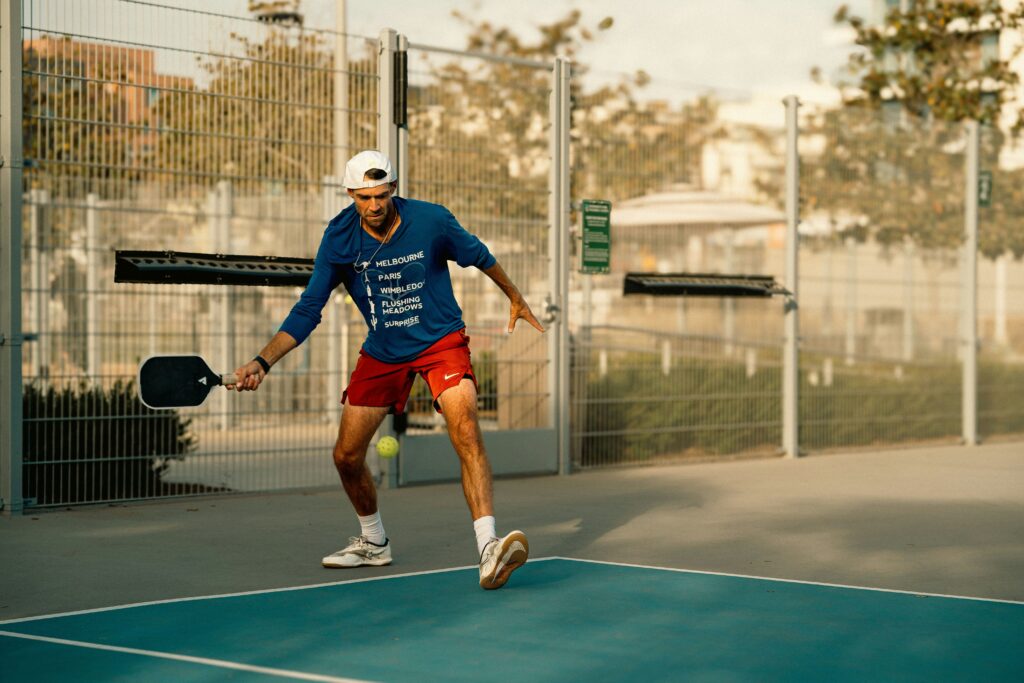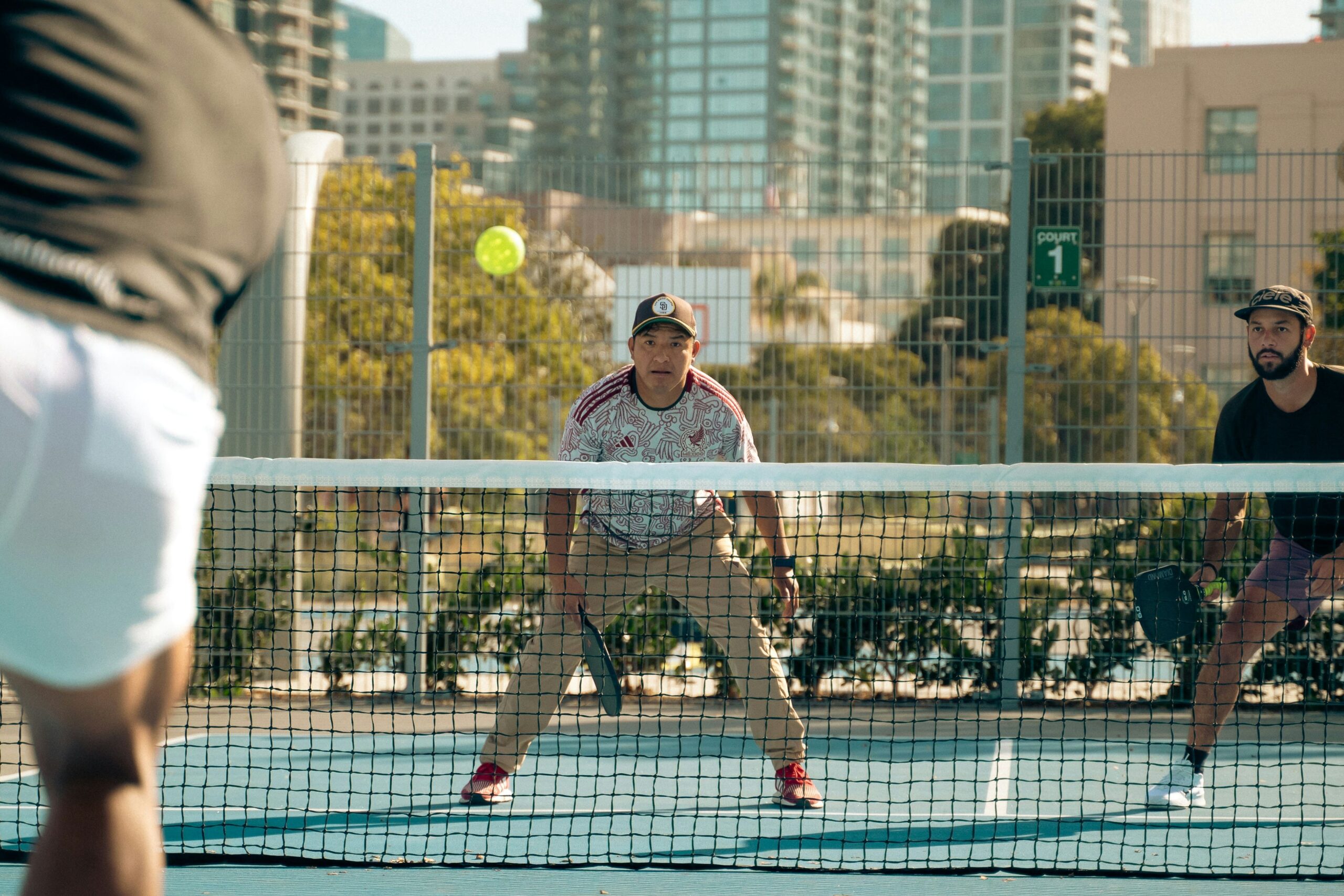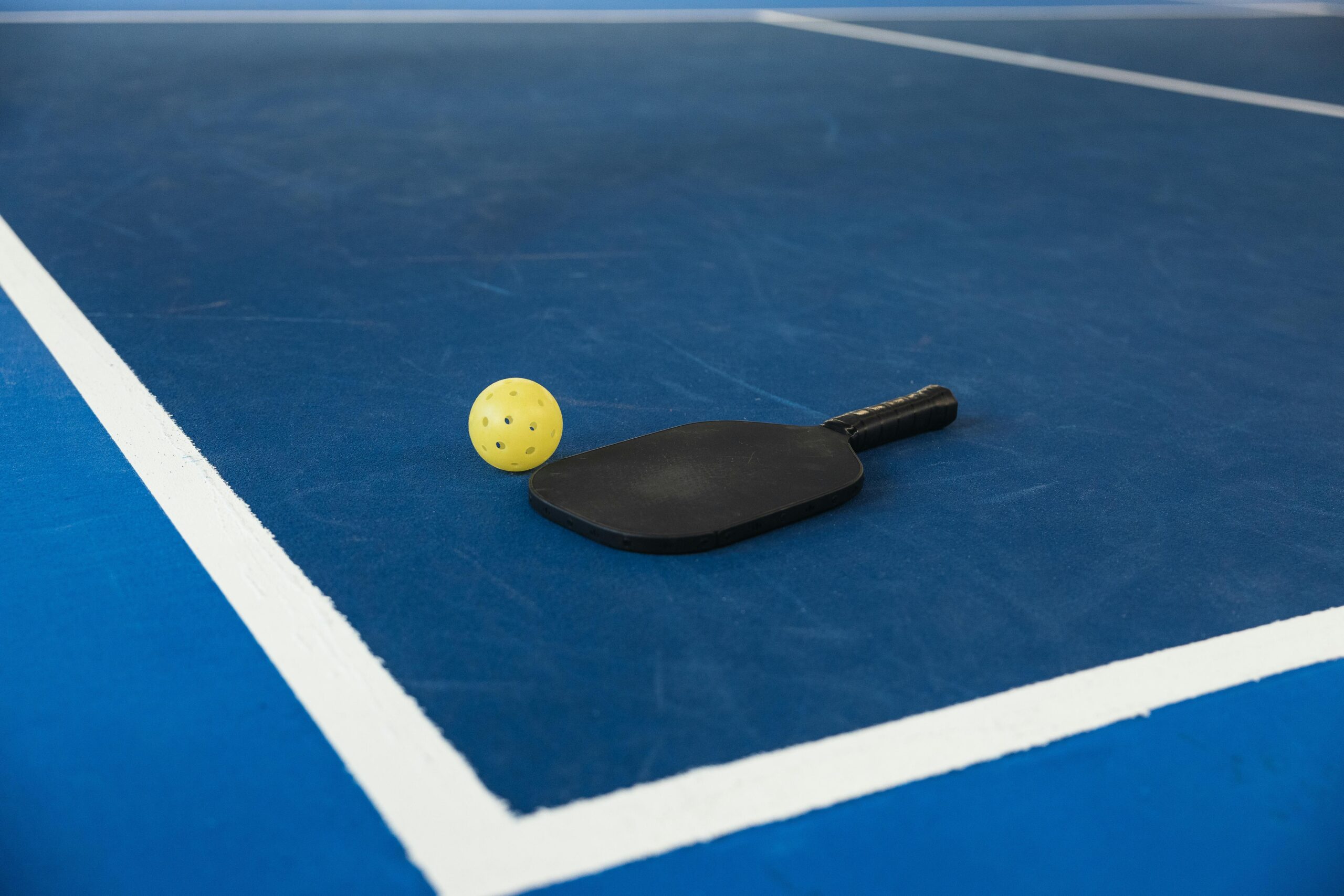In 2017, Roger Federer, at the age of 35, stunned the tennis world by winning the Australian Open against Rafael Nadal. Despite being older and arguably slower than his younger rivals, Federer relied on brilliant shot selection, precision, and strategic play to outmanoeuvre his opponents. Similarly, in table tennis, Jan-Ove Waldner, often called the “Mozart of Table Tennis,” was still competing at the highest level in his 40s, using his anticipation and placement skills rather than speed.
This trend is not limited to elite-level sports. In Pickleball, a strategy often beats sheer athleticism. An older player, or even a beginner with the correct strategies, can easily dominate younger, more athletic opponents.
In this guide, I’ll break down key pickleball strategy for beginners, from serving tactics to court positioning and shot selection. Whether you’re just starting out or looking to sharpen your skills, these strategies will help you play smarter, win more points, and enjoy the game even more. Let’s dive in!

Pickleball Tips for 3.0 Players: Building a Solid Foundation
At the 3.0 level, players must focus on consistency, control, and smart shot placement rather than power. Progressing requires refining technique, improving positioning, and developing patience to outlast opponents. Here are some tips for our 3.0s.
Master the Fundamentals: Serving & Return Strategy
A deep serve pushes opponents back, allowing more time to reach the net.
Your returns should be controlled and placed with purpose rather than rushed. Advancing quickly to the kitchen line after a return is crucial for dictating the pace of play.
Improve Your Dinking Game
Dinking should be precise and strategic, keeping shots low to prevent attack opportunities. Aim for your opponent’s feet to force errors, and use patience to outlast them in dink rallies rather than rushing for a winner.
Master the Double Bounce Rule & Positioning
Waiting for the ball to bounce before stepping forward prevents unnecessary errors. Proper positioning ensures better shot control and reduces excessive reaching or backpedaling, keeping you balanced and ready for the next shot.
Develop a Reliable Soft Game
Drop shots should be controlled and land in the kitchen to neutralize aggressive opponents. Learning to reset fast-paced shots helps regain control in high-pressure situations. Stepping into the non-volley zone should be intentional, not rushed.
Play Smart, Not Just Hard
Instead of relying on power, focus on smart shot placement. Reading your opponent’s movements allows for better anticipation and decision-making. Patience is key—forcing errors through consistency is often more effective than attempting outright winners.
By refining these aspects, 3.0 players can develop a strong foundation and prepare for the next level of competition.
Pickleball Tips for 3.5 Players: Elevating Your Game

At the 3.5 skill level, the focus shifts from simply keeping the ball in play to strategically controlling points. Instead of just reacting, you must now dictate rallies by using precise shot placement, forcing errors, and setting up winning plays. Here’s how you can refine your game to move beyond 3.0 and gain an edge on the court.
Sharpen Your Serve & Return Game
At 3.0, the goal was consistency, but at 3.5, serves and returns must become weapons. A deep, fast serve can push opponents back, while adding topspin or slice makes returns harder to attack. Instead of just returning safely, focus on keeping the ball deep to prevent opponents from rushing the net. Targeting their weaker side and following up with quick movement is key to controlling the rally. The third shot drop also becomes crucial—executing a well-placed drop helps transition from baseline play to net control.
Improve Your Net Game: Dinking with Purpose
Previously, dinking was about keeping the ball in play, but now it’s about placement and control. Crosscourt dinks give more margin for error, while short, well-placed dinks force opponents into tough spots. Instead of reacting passively, focus on moving your opponent and creating attack opportunities. Staying low, keeping dinks unattackable, and recognizing when to speed up play are essential upgrades at this level.
Master Volleys & Attacking Shots
Volleys are no longer just defensive tools—they should be used to apply pressure. Instead of blocking shots, use a controlled, compact punch to place the ball at your opponent’s feet or into open space. When facing aggressive shots, don’t just absorb power—redirect it smartly to regain control. Recognizing attackable shots and reacting quickly can turn defensive volleys into offensive opportunities.
Use Smart Shot Selection & Strategy
At 3.0, the focus was on keeping rallies alive, but at 3.5, shot selection determines control. Knowing when to drop the ball to slow down play versus when to drive it aggressively is crucial. Lobs become strategic tools to exploit weak overheads rather than desperation shots. The ultimate goal is to control the net—staying up front gives you the best chance to dictate points and force mistakes.
Conditioning & Training: The Edge You Need
At this level, fitness and footwork start making a real difference. Quick reactions, strong core stability, and endurance give you an edge over less-conditioned opponents. The best exercise for pickleball players targets the legs, core, and shoulders, with lunges for leg strength, planks for core stability, and shoulder rotations to enhance mobility, all of which improve agility, stamina, and endurance necessary for quick, controlled movements on the court.
By embracing these upgrades, 3.5 players can take control of their game, dictate play, and push toward even higher skill levels.
Pickleball Tips for Seniors: Outsmarting Younger Opponents
Pickleball is a game of strategy, finesse, and smart positioning—qualities that often improve with age and experience. Senior players may not always rely on speed and power, but they can excel by playing smarter, conserving energy, and using their court awareness to outmaneuver opponents. We have got few tips for our seniors as well.
Struggling to Keep Up? Slow the Game with Dinks
Younger players thrive on speed and power, but you can neutralize their aggression with well-placed dinks. A soft shot just over the net forces them to move forward, disrupting their rhythm and preventing them from hitting hard, fast-paced returns. The key is to keep your dinks low and unattackable, making it harder for your opponent to speed up the game.
Use the Third-Shot Drop to Regain Control
Instead of engaging in a fast volley exchange, seniors should master the third-shot drop. The most important shot in pickleball is the third shot drop. It’s the key to transitioning from the baseline to the net, allowing you to take control of the rally. A well-executed third shot drop lands softly in the kitchen, preventing your opponents from attacking and setting you up for a strong net game. Mastering this shot will give you a huge advantage as you improve
Target the Opponent’s Backhand for Easy Points
Most players, including younger ones, have a weaker backhand than their forehand. By consistently placing shots to their backhand side, you force them into uncomfortable returns, increasing their chances of making errors. Crosscourt dinks to the opponent’s backhand can be particularly effective, limiting their ability to attack.
Stay at the Kitchen Line to Reduce Running
Instead of staying at the baseline and chasing shots, move up to the kitchen line as soon as possible. Playing at the non-volley zone allows you to control the point with quick volleys, while also reducing unnecessary movement. A strong presence at the net forces your opponent to play softer shots, keeping the game at a manageable pace.
Use Deep Serves & Returns to Push Opponents Back
A well-placed, deep serve forces your opponent away from the net, making their next shot more predictable. Likewise, a deep return keeps them pinned at the baseline, giving you time to move up to the kitchen. This simple yet effective tactic prevents aggressive net play and gives you an early advantage in the rally.
Move Smart: Small Steps, Not Big Lunges
Many seniors struggle with unnecessary movement, leading to fatigue or injury. Instead of lunging or taking large strides, focus on short, controlled steps to stay balanced. Good footwork is essential for positioning yourself for dinks, volleys, and third-shot drops without overexerting yourself.
Advanced Pickleball Strategy for Beginners
You might think that Why Should Beginners Focus on Advanced Pickleball Strategy?
The fact is, many beginners remain stuck at lower skill levels because they rely only on basic shot-making without understanding strategic play.
A beginner who learns advanced strategies early can:
✔ Improve faster and avoid plateauing at the beginner level.
✔ Develop a unique playing style that suits their strengths.
✔ Compete effectively even against stronger or younger opponents.
But not all players will develop the same way. Some will rely on control and finesse, while others will use aggression and power. To help every type of beginner grow, here are three core strategic approaches that shape different styles of play.
Three Strategic Paths for Advanced Play
1. The Control-Based Player: Mastering Placement & Patience
Players who excel in this approach rely on precise shot placement rather than power. They use:
- Dinking battles to force errors.
- Third-shot drops to slow the game down.
- Angle shots and lobs to move opponents out of position.
This style is ideal for those who prefer a consistent, defensive game and want to win through patience and precision.
2. The Power-Based Player: Attacking & Speeding Up the Game
Some players thrive on aggressive, fast-paced play. To develop into this type of player, focus on:
- Drive shots that apply constant pressure.
- Volley exchanges at the net to attack weak returns.
- Fast third-shot drives instead of drops, forcing opponents into defensive positions.
This approach suits players who react quickly and want to take charge of rallies with high-speed play.
3. The Hybrid Player: Switching Between Power & Control
Advanced players develop the ability to mix styles based on their opponents. To adopt this approach:
- Know when to drop vs. drive—using soft shots against power players and fast shots against defensive players.
- Master resets to neutralize aggressive opponents.
- Use deception—changing pace and disguising shots to keep opponents guessing.
This approach works best for those who want versatility—being able to switch styles mid-game depending on the situation.
The beginner-question that gets asked commonly is, what is the best strategy for pickleball?
Based on the three broad strategies we’ve outlined for pickleball, the best strategy is to focus on controlling the net, maintaining consistent and strategic shot placement, and adapting your play based on your opponent’s weaknesses. By executing aggressive net play, placing shots to move your opponent out of position, and making smart adjustments during the game, you can dominate the court and increase your chances of winning.
Pickleball Tips for Serving
For many beginners, the serve is just a way to start the rally—but it can be so much more! A well-placed serve puts pressure on your opponent, forces weak returns, and gives you an edge right from the start.
If you want to refresh all the serving rules in pickleball, here is our comprehensive guide.
How to Play Pickleball: 8 Rules Beginners Always Get Wrong
Here’s how you can turn your serve into a weapon.
✅ Smart Serving Strategies
- Aim Deep to Push Your Opponent Back A deep serve that lands near the baseline makes it harder for your opponent to attack. It also gives you extra time to get into position. If you’re struggling with depth, try aiming a little higher and following through with your swing.
- Use a High-Arc Serve to Gain Time A higher, deeper serve isn’t just about getting the ball in—it gives you an extra second to react and get ready for the return. This is especially helpful if you find yourself caught off guard after serving. Try adding more height and see how it affects your opponent’s return.
- Add Spin and Mix Up Your Placement A little spin can go a long way! A topspin serve keeps the ball dipping fast, while a sidespin serve can throw off your opponent’s timing. You don’t need anything fancy—just a slight wrist flick can introduce spin and make your serve less predictable.
- Stick to a Routine for Consistency A good serve starts before you even hit the ball. Taking a deep breath, bouncing the ball once, and visualizing your target helps build muscle memory and improve accuracy. Try doing the same small routine before every serve—it’ll keep you focused and consistent.
- Think About the Next Shot A serve isn’t just about getting the ball in—it’s about setting up the next shot. Deep serves can force weak returns, giving you the chance to attack. Start paying attention to how your opponent reacts to different serves and adjust accordingly.
Mistakes to Avoid
- Serving Too Short A short serve is an invitation for your opponent to attack. If your serves keep landing short, aim higher and focus on extending your swing for better depth.
- Rushing the Serve Many beginners serve too fast and end up making mistakes. Take a second to reset, breathe, and focus before swinging—it makes a huge difference in consistency.
- Being Predictable If you always serve the same way, your opponent will catch on quickly. Try mixing in deep, high-arc, and spin serves to keep them guessing. A little variety can throw them off their rhythm.
- Overcomplicating Your Serve You don’t need a flashy, high-speed serve to be effective. A simple, reliable serve with good depth and placement will win you more points than a risky, inconsistent one. Master one solid serve first, then add more variety over time.
By making small adjustments and avoiding common mistakes, you can turn your serve into a real advantage. So next time you step up to serve, don’t just put the ball in play—make it count!
Advanced Pickleball At-Home Training Plan
Many people can’t hit the pickleball courts, as much as they want to, reason being work and other engagements. The common question among them is “How Can I Get Better at Pickleball at Home?“
Improving your pickleball game at home is not only possible but can be incredibly effective with the right plan. To help you take your skills to the next level, we’ve created a comprehensive At-Home Pickleball Training Plan designed specifically for beginners looking to improve their game without leaving the comfort of their own space.
Our training plan focuses on key areas like hand-eye coordination, footwork, core strength, and paddle control, using minimal equipment like a wall, cones, or targets, all of which are essential for pickleball success. Here’s a glimpse of how our plan can help you:
| Day | Exercise | Time | Skill Focus | Description | Equipment |
| Day 1 | Wall Dinking Drill | 15 min | Soft Touch & Control | Hit 50 controlled dinks against a wall, keeping the ball low and focusing on consistency. | Paddle, Pickleball, Wall |
| Cone Target Practice | 15 min | Shot Accuracy | Place cones on the floor and aim your dinks at specific spots to improve precision. | Paddle, Pickleball, Cones | |
| Footwork Ladder Drills | 10 min | Agility & Balance | Use an agility ladder (or tape markings) to improve foot speed and movement efficiency. | Agility Ladder / Tape | |
| Day 2 | Shadow Swing Drills | 15 min | Stroke Technique | Practice forehand and backhand swings in slow motion, focusing on proper form and balance. | Paddle |
| Ball Control with Paddle | 15 min | Hand-Eye Coordination | Bounce the ball on your paddle while moving to enhance control. | Paddle, Pickleball | |
| Core & Leg Strength Drills | 10 min | Stability & Endurance | Squats, lunges, and planks to strengthen core and leg muscles for better stability. | Bodyweight / Dumbbells (optional) | |
| Day 3 | Third Shot Drop Drill | 15 min | Precision & Strategy | Repeatedly practice third shot drops, aiming for a soft, controlled landing in the kitchen. | Paddle, Pickleball, Wall |
| Serve & Return Accuracy | 15 min | Shot Placement | Use floor markers or tape as targets to improve serve and return accuracy. | Paddle, Pickleball, Tape/Markers | |
| Reaction Volley Drill | 10 min | Reflex Speed | Have a partner or use a rebound surface to practice quick volley reactions. | Paddle, Pickleball, Rebound Surface |
Conclusion
Be it any level, the three essential skills needed to play pickleball are footwork, to position yourself effectively on the court, ball control, to accurately place and return the ball and strategic shot selection, to make smart decisions on when and where to hit different types of shots (e.g., dinks, volleys, and serves).
After all the information that we have bombarded you with, I am sure you wonder How to Get Better at Pickleball as a Beginner?
Improvement comes from structured practice, including footwork drills for quicker reactions, wall drills for better ball control, and match play for understanding strategic shot-making. Watching skilled players can also provide valuable insights into shot selection and positioning.
The At-home training allows you to sharpen precision, footwork, and shot selection, ensuring that when you step on the court, you’re always a step ahead.
Consistency, smart practice, and a strategic mindset will set you apart. Stick to the training plan, challenge yourself, and watch your game transform. The journey to becoming a better player starts today—commit, practice, and dominate!



